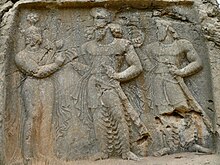Sarab-e Qandil relief
The Sarāb-e Qandil relief ( ice-cold spring , also often referred to as Tang-i Qandil relief ; Persian نقشبرجسته تنگ قندیل) is located in today's Iran near the city of Kazerun in the province of Fars . Also nearby are the ruins of Bishapur , which was a royal residence of the Sassanids .
The Sassanid relief, only discovered in 1970 by the Iranian archaeologist Ali Akbar Sarfaraz , shows three figures within a rectangular frame. In the middle stands a king who is mostly identified with Bahram II (ruled 276–293). A queen stands in front of him and presents him with a lotus flower. Both look at each other. Behind the ruler there is another man who is probably a prince, perhaps Bahram III. who was probably the couple's son. He holds the ring of power in his hand.
Like many Sassanid rock reliefs, it is found near a spring. It is the only relief that is carved into the adjacent rock here. The work is very well preserved, which is certainly due to the remoteness of the relief. Depicting a more intimate scene is not common in official Sassanid art. Otherwise, rock reliefs tend to show battles, triumphs or hunts. The scene of Sarab-e Qandil-Relief resembles the rock relief of Barm-e Delak , where the king also stands in front of the queen and presents her with a lotus flower.
The relief is not labeled, so the assignment to Bahram II must remain a guess. This thesis is mainly based on comparisons with coins. Bahram II is the only Sassanid ruler who is pictured there with his queen. Other researchers do not follow this identification and pursue the thesis that here Ardaschir I (reigned 224–239 / 40) is shown before a goddess. The prince would therefore be Shapur I. There is also the thesis that he is not a king, but a dignitary.
Rock reliefs were an art form typical of ancient Iran. Some rock reliefs date back to the time of the kingdom of Elam . Many of the reliefs date from the Sassanid Empire.
Web links
Individual evidence
- ^ Georgina Herrmann, DN Mackenzie, Rosalind Howell: The Sasanian Rock Reliefs at Bishapur. Part III: Bishapur I, The Investiture (Triumph of Shapur I?). Bishapur II, Triumph of Shapur I and Aarab-i Bahram, Bahram II enthroned. The Rock Relief at Tang-i Qandil (= Iranian monuments. Row 2: Iranian rock reliefs. Delivery 11). Reimer, Berlin 1983, ISBN 978-3-496-00731-9 , pp. 27–31, fig. 3, plates 25–32.
- ^ Louis Vanden Berghe: Reliefs rupestres de l 'Iran ancien. Les Musées, Brussels 1983, pp. 76-80.
- ↑ D. Levit-Tawil: Re-dating the Sasanian reliefs at Tang-e Qandil and Barm-e Dilak: composition and style as dating criteria. In: Iranica Antiqua , Volume 28 (1993), pp. 141-168.
- ↑ Hubertus von Gall, review of: Iranian monuments. Iranian rock reliefs, The Sasanian Rock Reliefs at Bishapur Part III. In: Gnomon , Volume 56, Issue 8 (1984), p. 764.
- ↑ The reliefs known to date are collected in: Louis Vanden Berghe: Reliefs rupestres de l 'Iran ancien. Les Musées, Brussels 1983.
Coordinates: 29 ° 53 ′ 2.4 " N , 51 ° 34 ′ 37.2" E

